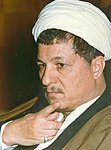| ||||||||||||||||||||
| Registered | 30,139,598[1] | |||||||||||||||||||
|---|---|---|---|---|---|---|---|---|---|---|---|---|---|---|---|---|---|---|---|---|
| Turnout | 54.59%[1] | |||||||||||||||||||
| ||||||||||||||||||||
| ||||||||||||||||||||
Presidential elections were held in Iran on 28 July 1989, after the death of Ayatollah Ruhollah Khomeini and the selection of Ayatollah Ali Khamenei, the previous President of Iran, as the new Supreme Leader of Iran. Out of the seventy-nine candidates registered to run, only two were approved by the Council of Guardians, which resulted in a very predictable win by Akbar Hashemi Rafsanjani, the previous Speaker of Majlis.
The Iranian constitution was amended by referendum on the same day.
Candidates
[edit]Disqualified candidates
[edit]The Guardian Council disqualified some candidates who enrolled to run for president, including:
- Ebrahim Yazdi, Head of Political Bureau of Freedom Movement of Iran[2]
Results
[edit]| 1989 Iranian presidential election | |||||||
|---|---|---|---|---|---|---|---|
| Party | Candidate | Nohen et al[3] | ISSDP[1] | ||||
| Votes | % | Votes | % | ||||
| Combatant Clergy Association | Akbar Hashemi Rafsanjani | 15,537,394 | 94.51 | 15,550,528 | 94.52 | ||
| Independent | Abbas Sheibani | 632,583 | 3.85 | 635,165 | 3.86 | ||
| Blank or invalid votes | 269,270 | 1.64 | 266,984 | 1.62 | |||
| Totals | 16,439,247 | 100 | 16,452,677 | 100 | |||
References
[edit]- ^ a b c "1989 Presidential Election", The Iran Social Science Data Portal, Princeton University, retrieved 10 August 2015
- ^ Rajaee, Farhang (2010), Islamism and Modernism: The Changing Discourse in Iran, University of Texas Press, pp. 156–157, ISBN 9780292774360
- ^ Nohlen, Dieter; Grotz, Florian; Hartmann, Christof (2001). "Iran". Elections in Asia: A Data Handbook. Vol. I. Oxford University Press. p. 76. ISBN 0-19-924958-X.


Well, that’s interesting to know that Psilotum nudum are known as whisk ferns. Psilotum nudum is the commoner species of the two. While the P. flaccidum is a rare species and is found in the tropical islands. Both the species are usually epiphytic in habit and grow upon tree ferns. These species may also be terrestrial and grow in humus or in the crevices of the rocks.
View the detailed Guide of Psilotum nudum: Detailed Study Of Psilotum Nudum (Whisk Fern), Classification, Anatomy, Reproduction